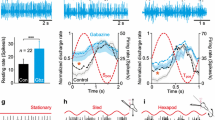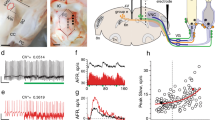Summary
Recent studies have shown that the interstitial nucleus of Cajal (INC) in the midbrain reticular formation is involved in the conversion of vertical semicircular canal signals into eye position during vertical vestibuloocular reflexes. Secondary vestibulo-ocular relay neurons related to the vertical canals, which constitute the majority of output neurons sending signals from the vestibular nuclei directly to the oculomotor nuclei, have been shown to project axon collaterals to the region within and near the INC. To understand how the INC is involved in the signal conversion, latencies of response of neurons in the INC region to electrical stimulaton of the vestibular nerve were examined in alert cats. The responses of 96 cells whose activity was clearly modulated by sinusoidal pitch rotation (at 0.31 Hz) were analyzed. These included 41 cells whose activity was closely correlated with vertical eye movement (38 burst-tonic and 3 tonic neurons), and 55 other cells (called pitch cells as previously). Twenty nine of the 96 cells (30%) were activated at disynaptic latencies following single shock stimulation of the contralateral vestibular nerve. Disynaptically activated cells were significantly more frequent for pitch cells than for eye movement-related cells (25/55 = 45% vs 4/41 = 10%; p < 0.001, Chi-square test). Conversely, cells that did not receive short-latency activation (< 6 ms) were more frequent among eye movement-related cells than pitch cells (26/41 = 63% vs 13/55 = 24%; p < 0.001, Chi-square test). Pitch cells showed significantly less phase lag (re head acceleration) than eye movement-related cells during sinusoidal pitch rotation (mean ± SD 124° ± 17° vs 138° ± 14°. p < 0.01, t-test). These results suggest that 1) cells in the INC region other than burst-tonic and tonic neurons mainly receive direct inputs from secondary vestibulo-ocular relay neurons, and that 2) vertical canal signals reach eye movement-related neurons mainly polysynaptically.
Similar content being viewed by others
References
Fukushima K (1991) The interstitial nucleus of Cajal in the midbrain reticular formation and vertical eye movement. Neurosci Res 10:159–187
Fukushima K, Fukushima J (1990) Activity of eye movementrelated neurons in the region of the interstitial nucleus of Cajal during sleep. Neurosci Res 9:126–139
Fukushima K, and Fukushima J (1991) Activity of eye movementrelated neurons in and near the interstitial nucleus of Cajal during sinusoidal vertical linear acceleration and optokinetic stimuli. Exp Brain Res 85:45–54
Fukushima K, Perlmutter SI, Baker JF, Peterson BW (1990a) Spatial properties of second-order vestibulo-ocular relay neurons in the alert cat. Exp Brain Res 81:462–478
Fukushima K, Fukushima J, Harada C, Ohashi T, Kase M (1990b) Neuronal activity related to vertical eye movement in the region of the interstitial nucleus of Cajal in alert cats. Exp Brain Res 79:43–64
Fukushima K, Harada C, Fukushmima J, Suzuki Y (1990c) Spatial properties of vertical eye movement-related neurons in the region of the interstitial nucleus of Cajal in awake cats. Exp Brain Res 79:25–42
Fukushima K, Murakami S, Matsushima J, Kato M (1980) Vestibular responses and braching of interstitiospinal neurons. Exp Brain Res 40:131–145
Fukushima K, Ohno M, Takahashi K, Kato M (1982) Location and vestibular responses of interstitial and midbrain reticular neurons that project to the vestibular nuclei in the cat. Exp Brain Res 45:303–312
Fukushima K, Suzuki Y, Fukushima J, Kase M (1991) Vestibular responses of eye movement-related neurons in the region of the interstitial nucleus of Cajal (NC) in alert cats. 3rd IBRO World congress of Neuroscience (Abstr), p 406
Fukushima K, Takahashi K, Fukushima J, Ohno M, Kimura T, Kato M (1986) Effects of lesion of the interstitial nucleus of Cajal on vestibular nuclear neurons activated by vertical vestibular stimulation. Exp Brain Res 64:496–504
Gacek RR (1971) Anatomical demonstration of the vestibuloocular projections in the cat. Acta Oto-laryngol Suppl 293:5–63
Goldberg JM Highstein SM, Moschovakis AK, Fernandez C (1987) Inputs from regularly and irregularly discharging vestibular nerve afferents to secondary neurons in the vestibular nuclei of the squirrel monkey. I. An electrophysiological analysis. J Neurophysiol 58:700–718
Graf W, Ezure K (1986) Morphology of vertical canal related second order vestibular neurons in the cat. Exp Brain Res 63:35–48
Graf W, McCrea RA, Baker R (1983) Morphology of posterior canal related secondary vestibular neurons in rabbit and cat. Exp Brain Res 52:125–138
Iwamoto Y, Kitama T, Yoshida K (1990a) Vertical eye movementrelated secondary vestibular neurons ascending in medial longitudinal fasciculus in cat. II. Direct connections with extraocular motoneurons. J Neurophysiol 63:918–935
Iwamoto Y, Kitama T, Yoshida K (1990b) Vertical eye movementrelated secondary vestibular neurons ascending in medial longitudinal fasciculus in cat. I. Firing properties and projection pathways. J Neurophysiol 63:902–917
King WM, Precht W, Dieringer N (1980) Synaptic organization of frontal eye field and vestibular afferents to interstitial nucleus of Cajal in the cat. J Neurophysiol 43:912–928
King WM, Fuchs AF, Magnin M (1981) Vertical eye movementrelated responses of neurons in midbrain near interstitial nucleus of Cajal. J Neurophysiol 46:549–562
McCrea RA, Strassman A, Highstein SM (1987) Anatomical and physiological characteristics of vestibular neurons mediating the vertical vestibulo-ocular reflexes of the squirrel monkey. J Comp Neurol 264:571–194
Robinson DA (1981) Control of eye movements. In: Brookhart JM, Mountcastle VB (eds) Handbook of physiology Vol 2, Part 2. Bethesda, American Physilogical Society, pp 1275–1320
Shimazu H, Precht W (1965) Tonic and kinetic responses of cat's vestibular neurons to horizontal angular acceleration. J Neurophysiol 28:991–1013
Wilson VJ, Melvill Jones G (1979) Mammalian vestibular physiology. Plenum, New York, pp 1–365
Wilson VJ, Ezure K, Timerick, SJB (1984) Tonic neck reflex of the decerebrate cat: response of spinal interneurons to natural stimulation of neck and vestibular receptors. J Neurophysiol 51:567–577
Author information
Authors and Affiliations
Rights and permissions
About this article
Cite this article
Fukushima, K., Suzuki, Y., Fukushima, J. et al. Latencies of response of eye movement-related neurons in the region of the interstitial nucleus of Cajal to electrical stimulation of the vestibular nerve in alert cats. Exp Brain Res 87, 254–258 (1991). https://doi.org/10.1007/BF00231842
Received:
Accepted:
Issue Date:
DOI: https://doi.org/10.1007/BF00231842




